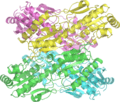Glycolysis facts for kids
Glycolysis is a super important process that happens inside most living things. Think of it as the first step in how your body (and other organisms) gets energy from food. It's cool because it works whether there's oxygen around (called aerobic respiration) or not (called anaerobic respiration). Glycolysis doesn't make a ton of energy on its own, but it sets the stage for more!
Scientists believe glycolysis is one of the oldest and most basic ways living things make energy. You'll find it, with slight changes, in almost every creature on Earth, from tiny bacteria to humans. Its widespread use shows just how ancient and important it is for life. This process involves ten steps, each helped by a special helper molecule called an enzyme. We'll just look at the main ideas here.
Contents
How Cells Get Energy: The Glycolysis Process
Glycolysis is a series of ten chemical reactions. These reactions break down a sugar molecule called glucose into smaller parts. It's like taking a big LEGO structure apart piece by piece.
The Energy Pay-off Phase
The second half of glycolysis is often called the 'pay-off phase'. This is when the cell starts to gain energy-rich molecules. These molecules are called ATP and NADH.
Remember, one glucose molecule gets split into two smaller sugar molecules earlier in the process. This means that each reaction in the pay-off phase happens twice for every original glucose molecule.
In this phase, the cell produces 2 NADH molecules and 4 ATP molecules. However, because some ATP was used at the start, the net gain is 2 NADH molecules and 2 ATP molecules from glycolysis for each glucose molecule.
Quick Summary: From one glucose molecule, you get a net production of 2 ATP molecules, 2 NADH molecules, and 2 pyruvate molecules.
Glycolysis and Aerobic Respiration
Cells that perform aerobic respiration (which means they use oxygen) make a lot more ATP. This extra energy isn't made during glycolysis itself. Instead, the pyruvate molecules created by glycolysis are used in further reactions.
For example, in Eukaryote cells (like those in your body), aerobic respiration can produce about 30 additional ATP molecules for each glucose molecule. This shows how glycolysis is just the beginning of a much larger energy-making process.
However, when there isn't enough oxygen, glycolysis through anaerobic respiration becomes the main way many cells get their energy.
Related pages
- Cellular respiration (overview)
- Link reaction
- Krebs cycle (Citric acid cycle)
- Electron transport chain (ETC)
Images for kids
-
Yeast hexokinase B, an important enzyme in glycolysis.
-
Yeast pyruvate kinase, an enzyme involved in the final steps.
See also
 In Spanish: Glucólisis para niños
In Spanish: Glucólisis para niños






